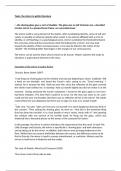Topic: the mirror in gothic literature
‘…the shaving-glass gave a sort of shudder. The glass was an old Victorian one, a bevelled
circular mirror in a pivoted brass frame, on a porcelain base.’
The mirror motif is a key element of the Gothic, often symbolising identity, sense of self and
vanity, or possibly an ethereal, ghostly other world. It can also be affiliated with a crisis of
identity, or self-loathing. In a psychological sense, mirrors symbolise the threshold between
the conscious mind and the unconscious mind. By looking into a mirror, one may look
towards the depths of their unconsciousness. It can also be linked to the notion of the
‘double’- the terrifying Other that lingers in the margins of our consciousness.
The mirror can be used to show what it means to be human- Waters subverts this trope to
introduce a supernatural element to the story.
Examples of the mirror in gothic fiction
Dracula, Bram Stoker (1897)
‘I had hung my shaving glass by the window and was just beginning to shave. Suddenly I felt
a hand on my shoulder, and heard the Count's voice saying to me, "Good morning." I
started, for it amazed me that I had not seen him, since the reflection of the glass covered
the whole room behind me. In starting I had cut myself slightly but did not notice it at the
moment. Having answered the Count's salutation, I turned to the glass again to see how I
had been mistaken. This time there could be no error, for the man was close to me, and I
could see him over my shoulder. But there was no reflection of him in the mirror! The whole
room behind me was displayed, but there was no sign of a man in it, except myself.
...
"Take care," he said, "take care how you cut yourself. It is more dangerous that you think in
this country." Then seizing the shaving glass, he went on, "And this is the wretched thing
that has done the mischief. It is a foul bauble of man's vanity. Away with it!" And opening
the window with one wrench of his terrible hand, he flung out the glass, which was
shattered into a thousand pieces on the stones of the courtyard far below.’
In this passage, the mirror is used to introduce the supernatural into the novel. In both The
Little Stranger and Dracula, the mirror is specifically a ‘shaving glass’ and both characters
end up being cut by the mirror. In addition, both mirrors end up being shattered on the
floor. Whilst there are several similarities between the scenes, the difference seems to be
that in Dracula, the mirror is used to convey astonishment, or confusion. Waters uses the
mirror to instil terror in Roderick and the reader.
The Lady of Shalott, Alfred Lord Tennyson (1833)
‘The mirror crack’d from side to side;




